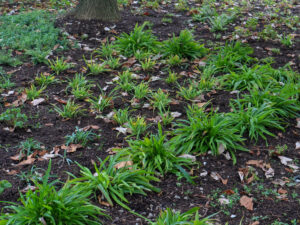
Oaks (Quercus sp.) are one of the most ecologically important genus of trees that are native to the North Eastern United States. This is because they can host over 500 species of moth and butterfly larvae. Moths and butterflies are important plant pollinators, many species of which are specialized to specific native host plants. The larvae are so specialized to their host plants that many young caterpillarswould not be able to survive if their eggs were laid on the wrong species of plant. With the alarming loss of insect diversity on the rise, it is more important than ever that we care for our pollinators at all stages of their lives.
One aspect of pollinator support that is often overlooked in urban park care is what is happening underneath the trees and how that space affects insects. Not every caterpillar is capable of creating a chrysalis that can attach and hang from a leaf or a branch, many end up falling to the ground below. In a forest setting, these falling pupates would have plenty of forest duff or fallen leaves to nestle into until they are ready to hatch. In urban and suburban environments, this space is traditionally occupied by concrete or mulched rings surrounded by mowed lawns. This creates quite the obstacle for our pollinator populations as many of these chrysalis are destined to be stepped on or mowed over before they can ever reach adulthood and reproduce themselves.


The solution to this problem is to create a “soft landing” for these insects to fall onto.. These native understory perennials will act as a sort of cushion to provide habitat to hatching moths and butterflies. Flowering plants can and should be incorporated into this mix to provide not only extra beauty, but a valuable food source for our newly-winged friends.
The Rose Kennedy Greenway is experimenting with our first intentional soft landing planting in the Wharf District under two mature swamp white oak trees (Quercus bicolor) that are situated in one of our lawn spaces. We will continue to monitor the health of our pollinator populations as well as the health of our plants as we carry on our search for opportunities to be inclusive to all life that exists on the Greenway.



